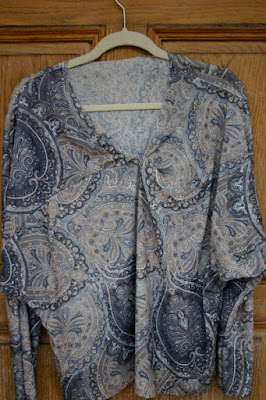

This favorite, but OOP, Vogue pattern is from their now-defunct NY/NY line. The pattern features a jacket and a 5-gore, spiral skirt. The pattern says there is no accommodation for shortening or lengthening the skirt but, at a finished length of 24", I decided I was going to lengthen it, and also to convert it from a faced waistband with a zipper to an elastic waist. When a pattern says there is no accommodation for lengthening or shortening a design, all that means is that they don't want to be bothered with it because it is not straightforward. It does not mean you can't figure out a way to do it. ;) The "more correct" way to do it would be to completely redraft the spirals, but I didn't want extra width at the hips anyway, so my approach achieved the look I was after.
You can see my altered pattern piece in the photo below. I started with a size 16, increased the waist to the same measurement as the hip, and added 6" to the top of the pattern. If you read the reviews of this skirt on
Pattern Review, there was an error in the original printing of the pattern. If you followed the original instructions, you would cut the spiral on the folded fabric, which would cause the spiral from the top layer to go in the opposite direction of the spiral from the bottom layer. Later printings of the pattern corrected the layout, telling you to cut the skirt in a single layer, with all spirals going in the same direction. My pattern, from ebay, shows the earlier layout.

My altered pattern piece for the gore. The smaller pattern piece is attached to four of the gores to lengthen them. There is another pattern piece, which is longer and wider, that is attached to the 5th gore so that it creates an asymmetric hem.
Once you cut out the 5 upper gores, you then cut out 5 bottom pieces, each one is sewn to the bottom of the gore to lengthen it. Four of the bottom pieces have the same shape, but one is larger/longer, causing the skirt to have an asymmetric hem.
The fabric I used is from Emma One Sock. I purchased it several months ago when I was looking for a cotton/linen blend denim. This fabric, a linen silk blend in a twill weave, is a charcoal color. When it arrived, it was not what I wanted for the project in mind, so I tossed it into a pile. When I decided to make this skirt, I realized it would be perfect. The fabric has a gorgeous hand, beautiful drape, and went through the washer/dryer like a champ. The two yards I bought was not enough for the pattern, but I was able to very carefully squeeze it out.
Sewing the skirt is fairly straightforward, but the process is similar to sewing a tapered circular ruffle to another tapered circular ruffle, and so on, until you have 5 circular ruffles sewn together. Hemming it was a bit challenging, but I sewed close to the edge of the hem, trimmed, made a tiny 1/8" turn of the fabric, and topstitched.

Hemming the skirt with a 1/8" hem.
And here is the final result. I was getting ready to go to a BABES meeting. I'm not sure exactly what that stands for, but it's a Bay Area Sewing Group from PR. I had just washed my hair,
and it had been raining, so that's why I look like a drowned rat. :)


















































